Special Report
These Are The Presidents Who Served in the Military
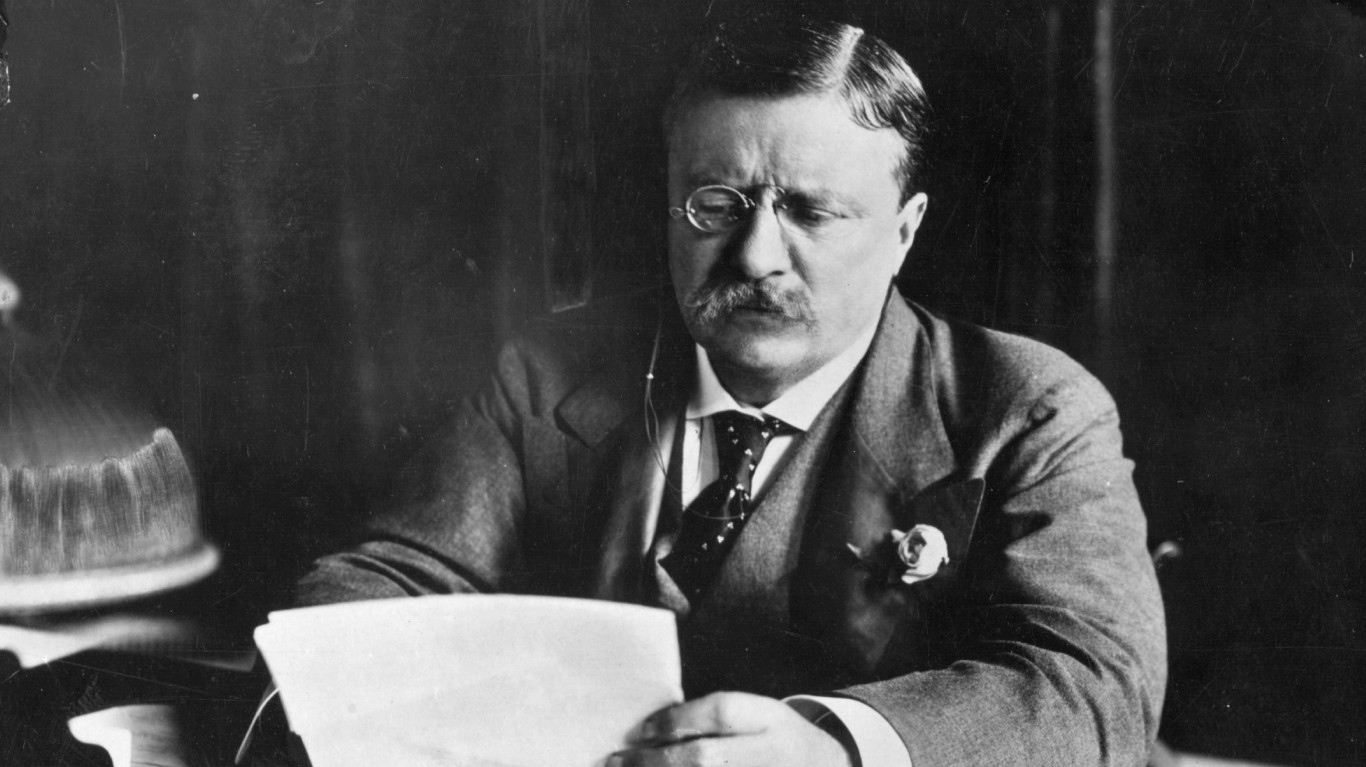
Published:

Serving as commander-in-chief, as well as the head of state and government, American presidents are granted tremendous power. As such, a track record of dedication to public service has been a prerequisite for nearly all those who successfully run for the highest office, with few exceptions. And no occupation better demonstrates a willingness to sacrifice for the country than military service.
Since America’s founding, a total of 45 men have served as president. Of them, all but 14 had a background of at least some military service.
24/7 Wall St. reviewed the biographies of every American president to identify those who have served in the military. Presidents are listed in the order in which they served as president.
For many of the presidents on this list, military service was a small part of careers that also spanned other areas, such as business, law, or local or state politics. Men such as George H.W. Bush and John F. Kennedy, for example, enlisted in part because of the outbreak of World War II, and moved on to civilian careers at the war’s end. Here is a look at each president’s path to the Oval Office.
Less common are men whose careers were defined largely by the military, and whose distinguished service launched them into national politics. These former presidents include Dwight Eisenhower, a four-star general who served as supreme commander of allied forces in World War II, and most famously, George Washington, who led the Continental Army to victory over the British in the Revolutionary War. Here is a look at the most decorated war heroes in American history.
Notably, military service has not been a common credential among more recent American presidents. Of the last five presidents, from Bill Clinton to Joe Biden, only one – George W. Bush – served in the military. And though Bush was a trained fighter pilot during the Vietnam War, he was never sent into combat.
Click here to see the presidents who served in the military
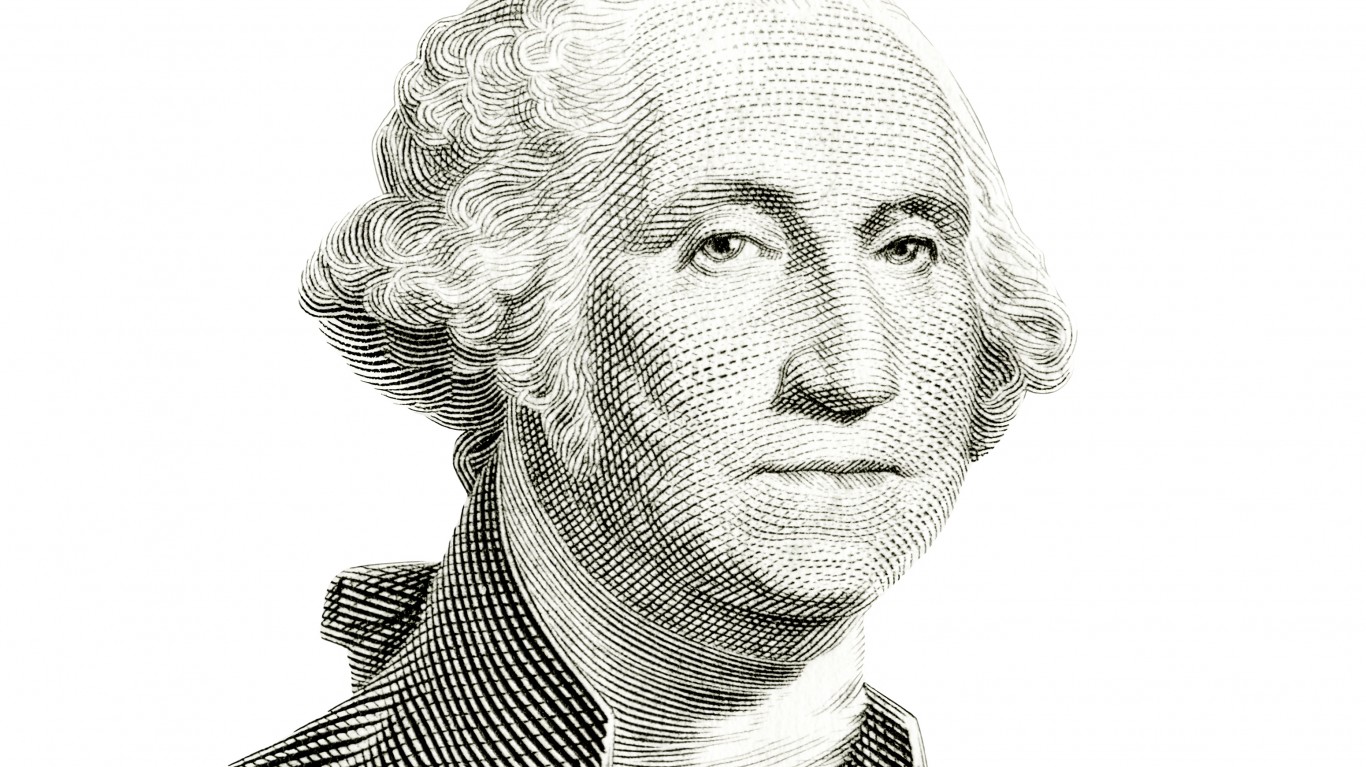
1. George Washington
> Branch of service: U.S. Continental Army
> Highest military rank achieved: General
> Year(s) as president: 1789-1797
George Washington’s military career began in 1753, on the eve of the French and Indian War, when he traveled to the Ohio Valley to meet with the French at the behest of Virginia’s Lieutenant Governor. On his journey, it became clear to Washington that the French were planning to attack the British, and he traveled back to Virginia on foot to warn the colonists. For his courage he was promoted to lieutenant colonel and served with distinction throughout the war.
His experience leading troops in the French and Indian War made Washington an obvious choice for commander-in-chief at the outbreak of the Revolutionary War. His unlikely victory over the British directly led to his unanimous election as the first president of the United States.
[in-text-ad]
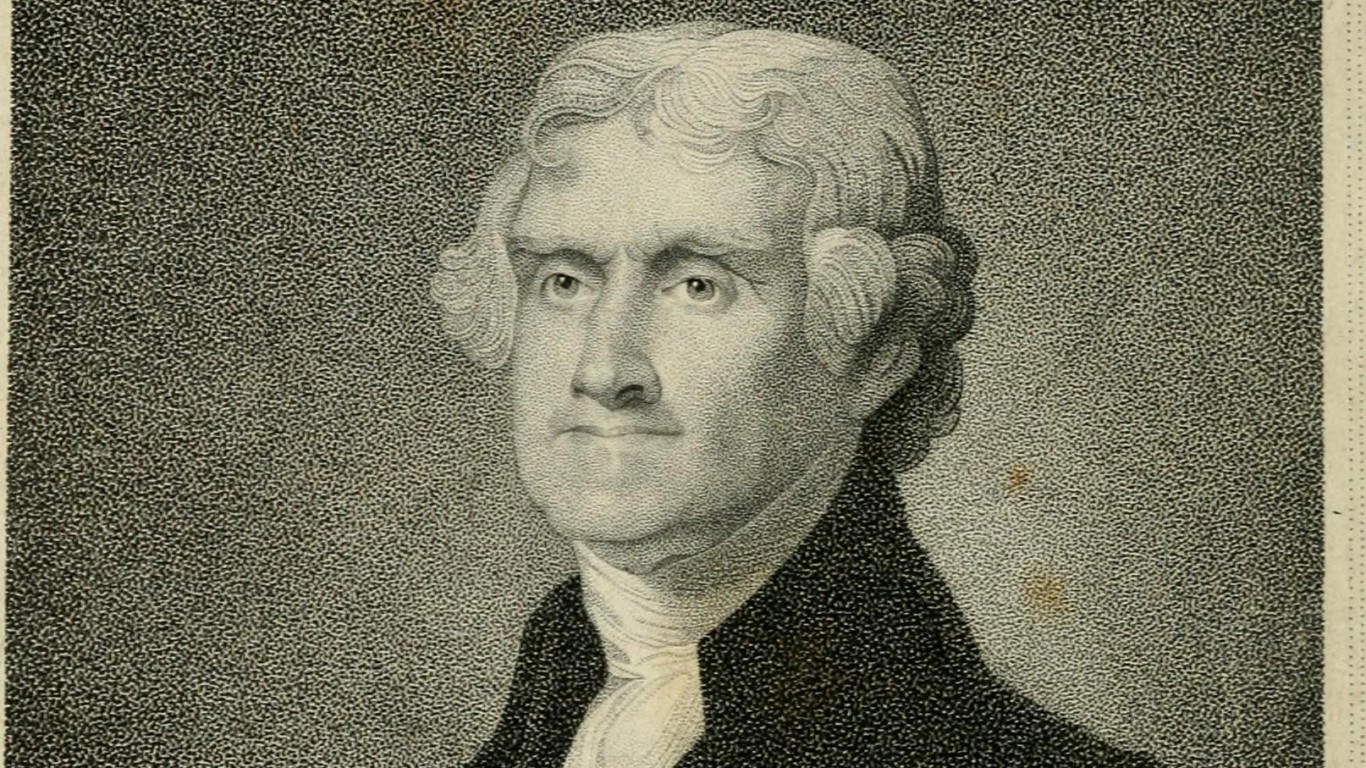
2. Thomas Jefferson
> Branch of service: Virginia Militia
> Highest military rank achieved: Colonel
> Year(s) as president: 1801-1809
Thomas Jefferson was the third president of the United States and the second president with a background of military service. Years before his powerful writing style and influential arguments against British control of the colonies thrust him to the center of colonial politics, Jefferson had built a reputation as colonel of the Albemarle County Regiment of the Virginia Militia.
Jefferson’s responsibilities included running drills for his regiment, presiding over court marshalls, and, following the outbreak of the Revolutionary War, sending his troops to reinforce the Continental Army. Jefferson’s reputation suffered, however, when, following the British capture of Richmond, he fled his Virginia home rather than staying to fight.
3. James Madison
> Branch of service: Virginia Militia
> Highest military rank achieved: Colonel
> Year(s) as president: 1809-1817
Like his close friend, political ally, and fellow Founding Father Thomas Jefferson, James Madison served in the Virginia Militia. Initially serving as a private in 1775, he was quickly commissioned as colonel of the militia’s Orange County Regiment. Restricted from active service by poor health, Madison made a name for himself managing all militia affairs in the county, including training.
Today, Madison’s military service is a footnote in the history books, as he subsequently served as secretary of state under Jefferson, was elected as the fourth president of the United States, and was the chief architect of the U.S. Constitution.
4. James Monroe
> Branch of service: Continental Army
> Highest military rank achieved: Major
> Year(s) as president: 1817-1825
James Monroe enlisted in the Virginia infantry following the battles of Lexington and Concord at the outbreak of the Revolutionary War. Before long, Monroe was serving as an officer in the Continental Army in New York under General George Washington. Unlike many other U.S. presidents who served in the military, Monroe saw plenty of combat, serving with distinction in the battles of Monmouth, Brandywine, Germantown, and Trenton, where he suffered a life-threatening shoulder wound leading a charge against a British cannon.
Though he earned the rank of major, Monroe resigned from the Continental Army before the end of the war, as a glut of officers left little opportunity for him to command troops in battle. Monroe’s combat experience proved useful when he served as secretary of war under President Madison during the War of 1812, a role that enhanced his national reputation and helped elevate him to the presidency in 1817.
[in-text-ad-2]
5. Andrew Jackson
> Branch of service: U.S. Army
> Highest military rank achieved: Major General
> Year(s) as president: 1829-1837
Andrew Jackson was too young to formally enlist during the Revolutionary War, though he joined the fight with a group of American irregulars. The end of the war found the 16 year old Jackson orphaned and a combat veteran. Following a successful stint in Tennessee politics, Jackson led a force of Tennessee Militia troops to southern Alabama where he wiped out a force of Creek Indians who had been killing European settlers. The campaign’s success led to his appointment as a major general in the U.S. Army during the War of 1812, where his lopsided victory against the British at the Battle of New Orleans made him a hero.
Following the war, Jackson continued violent campaigns against Indians in the South. Later returning to politics, he served as governor of the Florida Territory and was eventually sworn in as the seventh president of the United States in 1829. His brutal treatment of Native Americans has made Jackson one of the most controversial American presidents to this day.
6. William Henry Harrison
> Branch of service: U.S. Army
> Highest military rank achieved: Major General
> Year(s) as president: 1841
William Henry Harrison made a name for himself in the military. As a young man, he quickly moved up the ranks from ensign to lieutenant, earning a citation from his general for “conduct and bravery exciting the troops to press for victory” in a skirmish with Native Americans at Fort Washington in 1794. He later served as the governor of the Indiana Territory for 12 years, before returning to the battlefield.
As governor, Harrison expanded the U.S. further into Native American land with exploitative treaties, drawing the ire of the local chief, Tecumseh. In 1811, Harrison led troops to attack Native resistance, but his party was ambushed. He rallied his troops and repelled the surprise attack and routed retreating survivors. Shortly after, Harrison served as a major general during the War of 1812. Before becoming president, he served as a senator for Ohio and ambassador to Colombia. Harrison is the shortest-serving president in American history. He died of pneumonia after serving just 32 days. It is believed he caught pneumonia because he spoke for two hours in bad weather during his inauguration.
[in-text-ad]

7. John Tyler
> Branch of service: Virginia Militia
> Highest military rank achieved: Captain
> Year(s) as president: 1841-1845
Though John Tyler did serve in the U.S. military during a war, he had one of the least eventful military careers of any president who served. Tyler was in his early 20s when the War of 1812 broke out. He served as captain of a small militia company in Virginia, but he and his troops did not see any action in the conflict.
After the war, Tyler served as a U.S. congressional representative, a U.S. senator, and governor of Virginia. While the nation was growing increasingly divided on slavery, Tyler was added to the Whig Party’s presidential ticket as the running mate of William Henry Harrison to entice southern voters for the 1840 election. Harrison and Tyler won, though Harrison’s presidency lasted just over a month, as he became the first president to die in office. Tyler’s term was a difficult one, as he had little support from the cabinet Harrison appointed and was even expelled from his own party. Tyler opted not to run for re-election.
8. James K. Polk
> Branch of service: Tennessee Militia
> Highest military rank achieved: Colonel
> Year(s) as president: 1845-1849
James K. Polk was unhealthy as a child, but worked and studied hard for his whole life, as much was expected of him as the eldest of 10 children. He graduated from college and was admitted to the Tennessee state bar in 1820. He served in a local militia in 1821, attaining the rank of colonel. However, his time in the military was uneventful.
As president, Polk expanded the footprint of the U.S. more than any other president since Jefferson. He was a strong proponent of Manifest Destiny – the concept that the U.S. should expand from coast to coast. He spurred the U.S. to go to war with Mexico, which was a resounding victory for the Americans. Mexico ceded much of what is now the Western U.S. in a treaty to end the war.
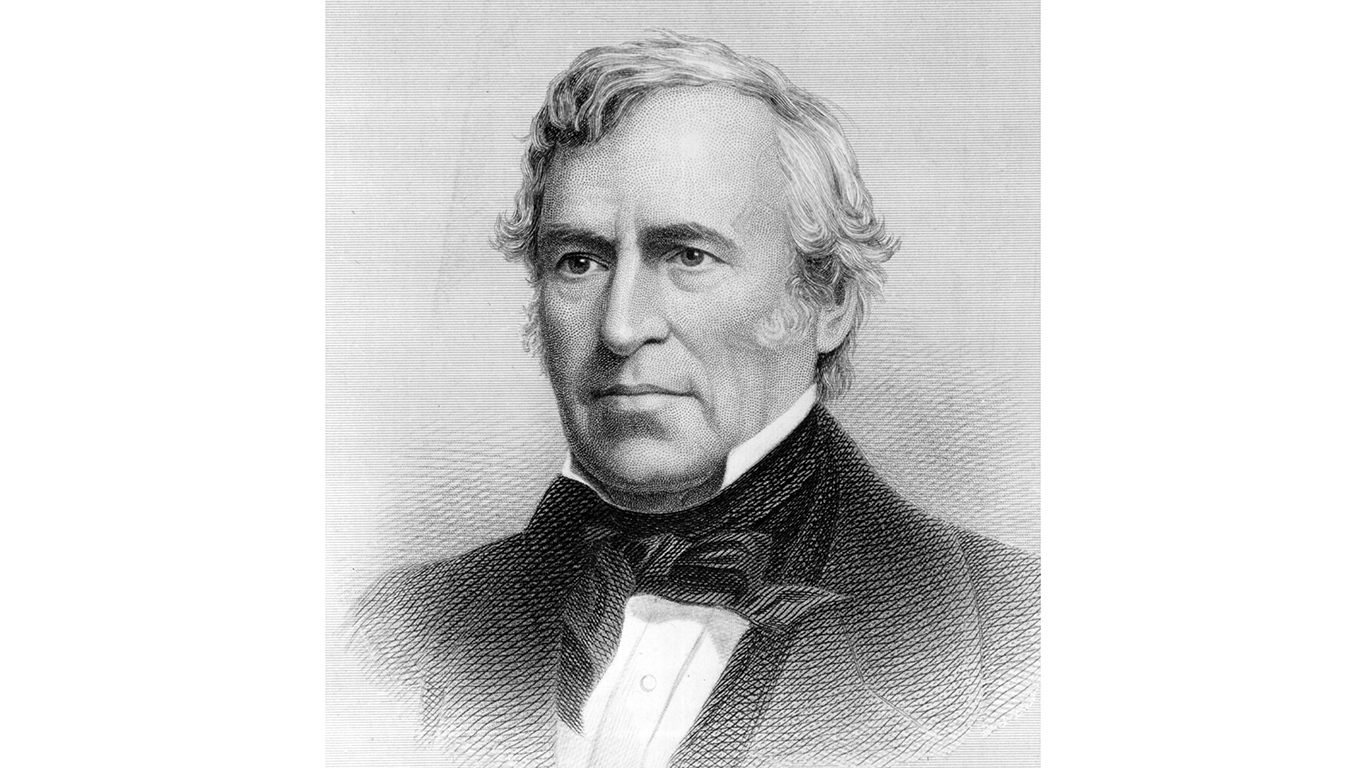
9. Zachary Taylor
> Branch of service: U.S. Army
> Highest military rank achieved: Major General
> Year(s) as president: 1849-1850
Throughout his childhood, Zachary Taylor wanted a career in the military. He spent almost all of his pre-presidency adulthood serving in the Army. His first commission came in 1808, when he commanded a garrison at Fort Pickering in Tennessee. For decades, he fought against Native Americans in various settlements and forts across the continent.
Taylor earned nationwide recognition as an excellent leader – the nickname “Old Rough and Ready” – during the Mexican-American War, when he led his troops to decisive victories over the Mexican army in Palo Alto, Monterrey, and Veracruz. This notoriety pushed Taylor into politics, as many Americans supported him as a presidential candidate before he even threw his hat in the ring.
[in-text-ad-2]
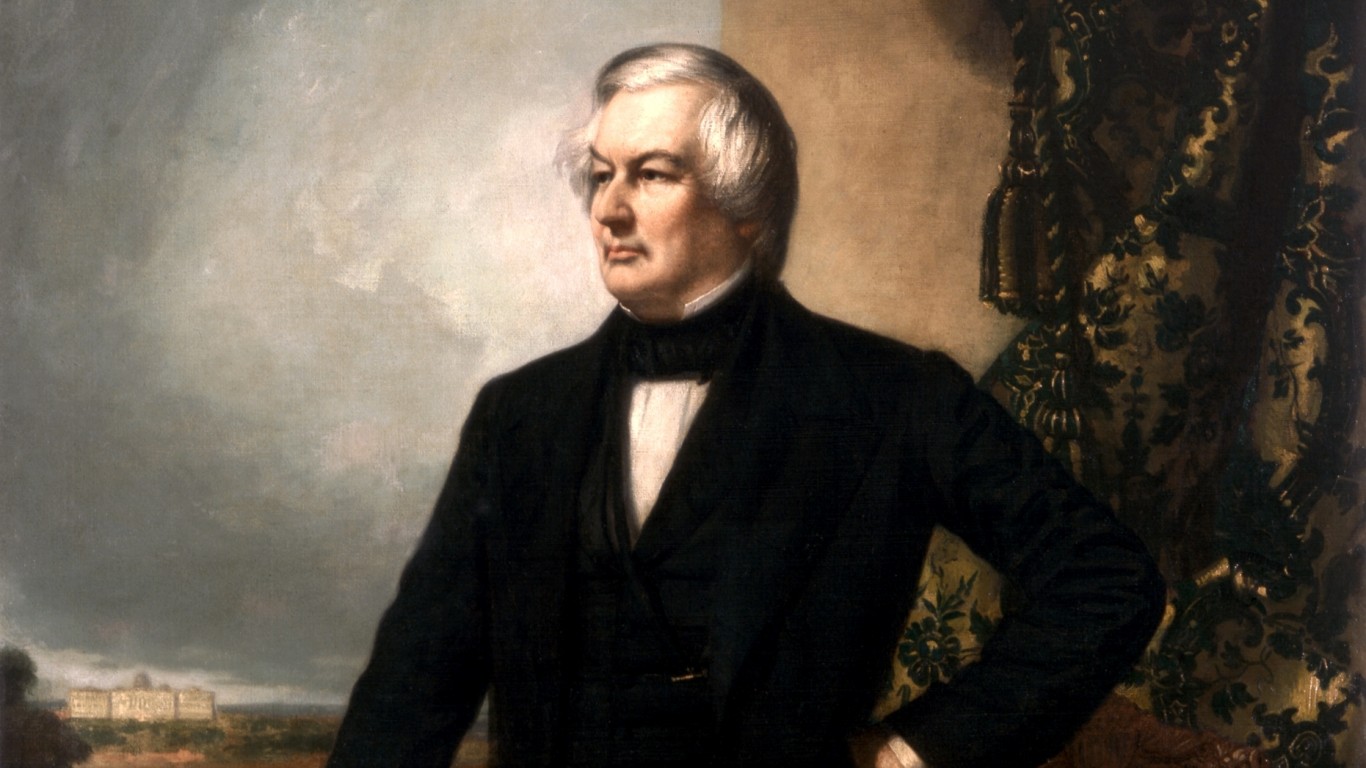
10. Millard Fillmore
> Branch of service: Union Continentals
> Highest military rank achieved: Major
> Year(s) as president: 1850-1853
Millard Fillmore is a historical anomaly in that his military service only came after his time as president. Fillmore, from New York, was added to the Whig Party ticket as the vice presidential nominee in 1848 to appease northerners and abolitionists, as presidential nominee Zachary Taylor was a slave owner from the South. The two did not see eye to eye, and Fillmore had little power – until Taylor died and Fillmore became president.
As president, Fillmore pushed through the Compromise of 1850, which aimed to keep the balance between slave and free states. Yet the compromise seemed to upset both pro- and anti-slavery Americans, and Fillmore was not even nominated by his party to run for reelection. When the Civil War broke out years later, Fillmore commanded a militia known as the Union Continentals, a group of men who aimed to defend Buffalo and Western New York if the Confederates attacked the area, which they never did.
11. Franklin Pierce
> Branch of service: New Hampshire Militia
> Highest military rank achieved: Brigadier General
> Year(s) as president: 1853-1857
Franklin Pierce grew up in a political family in New Hampshire. His father, Benjamin, was a Revolutionary War hero and was elected governor. Pierce followed in his footsteps, becoming a state legislator in 1829, then a U.S. representative in 1832, and a senator in 1837.
Pierce enlisted in the military in part to further his political ambitions. He joined the New Hampshire Volunteers as a private, rounding up other locals to join as well to go fight in the Mexican-American War. He used his political connections with President Polk to land himself a role as brigadier general in charge of over 2,000 troops. Pierce saw combat but was thrown from his horse and broke his leg, passing out from the pain. He was unable to fight in the decisive Battle of Chapultepec, but now he had a war record and turned his attention to the presidency.
[in-text-ad]
12. James Buchanan
> Branch of service: Pennsylvania Militia
> Highest military rank achieved: Private
> Year(s) as president: 1857-1861
James Buchanan was the eldest son of a relatively well-to-do Pennsylvania family. As such, he had the opportunity to attend college and became a practicing lawyer. But just after being admitted to the bar, Buchanan enlisted in a local militia during the War of 1812. He saw no action and quickly returned to his legal career.
Like most of his immediate predecessors, the question of slavery loomed large in Buchanan’s presidency. He attempted to appease both pro-slavery and abolitionist political leaders. In doing so, he managed to upset both factions of the country, pushing the U.S. further down the path of Civil War.
13. Abraham Lincoln
> Branch of service: Illinois Militia
> Highest military rank achieved: Captain
> Year(s) as president: 1861-1865
Before becoming president, Abraham Lincoln grew up very poor in Kentucky and on the frontier of Indiana. As a young man, he moved to Illinois where he ran a general store. He initially wanted to get into politics, announcing his candidacy for a seat in the Illinois state legislature, but he put his plans on hold when the Black Hawk War broke out in 1832.
Lincoln volunteered to join the conflict, in which Native Americans sought to fight for tribal lands white settlers had moved into. Popular among his compatriots, Lincoln was elected captain of his company. He served three back-to-back stints in the militia, totaling about three months, though he never saw any action.
14. Andrew Johnson
> Branch of service: U.S. Army
> Highest military rank achieved: Brigadier General
> Year(s) as president: 1865-1869
Andrew Johnson received one of the most unorthodox military appointments of any American who would go on to be president. After starting his career as a tailor, Johnson slowly worked his way up the political ladder. He went from town alderman to the mayor of Greenville, Tennessee. He then became a state legislator, state senator, U.S. representative, and governor of Tennessee. Johnson was in his first term as a U.S. senator when the Civil War broke out.
Though he owned slaves, Johnson favored keeping the Union together and honoring previously-agreed compromises. He was the only Southern senator who did not resign from the senate ahead of the war, and became a staunch supporter of President Lincoln. When the Union Army took control of Tennessee during the war, Johnson was made military governor of his own state, which came with the power to enact discharge executive, legislative, and judicial functions, along with the military rank of brigadier general. Johnson ensured order in Tennessee throughout the duration of the war. Johnson was selected as Lincoln’s running mate for a second term, and he took office following Lincoln’s assassination.
[in-text-ad-2]
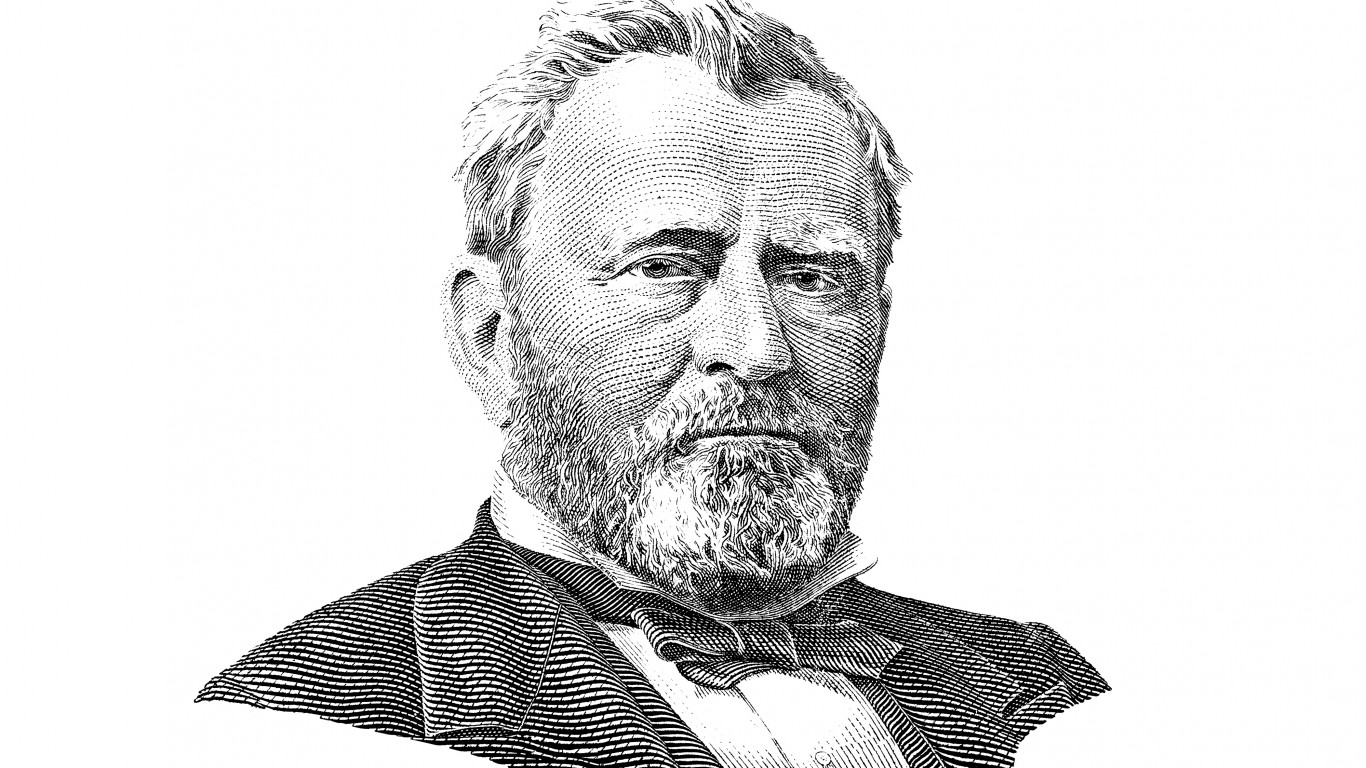
15. Ulysses S. Grant
> Branch of service: U.S. Army
> Highest military rank achieved: General
> Year(s) as president: 1869-1877
Though he served two full terms as president, Ulysses S. Grant is still often remembered more for his military achievements than his time in office. Grant got his start in the military after being accepted to the U.S. Military Academy at West Point. As a lieutenant, he served during the Mexican War, receiving two citations for bravery on the battlefield. Grant left the Army in 1854 but struggled to make ends meet as a civilian. He eventually had to ask his brother for a job at his leather shop.
Once the Civil War broke out, Grant was appointed the leader of an unruly volunteer regiment out of Illinois, gradually turning them into a disciplined fighting force. While higher-ranking Union leaders floundered, Grant led his troops to victory on numerous occasions, earning promotions along the way. By 1864, President Lincoln put Grant in charge of all Union forces. The following year, Grant accepted General Robert E. Lee’s surrender, ending the Civil War. His war efforts made Grant a serious presidential candidate. Though his presidency would be marred by corruption, Grant is still remembered for his actions during the Civil War.
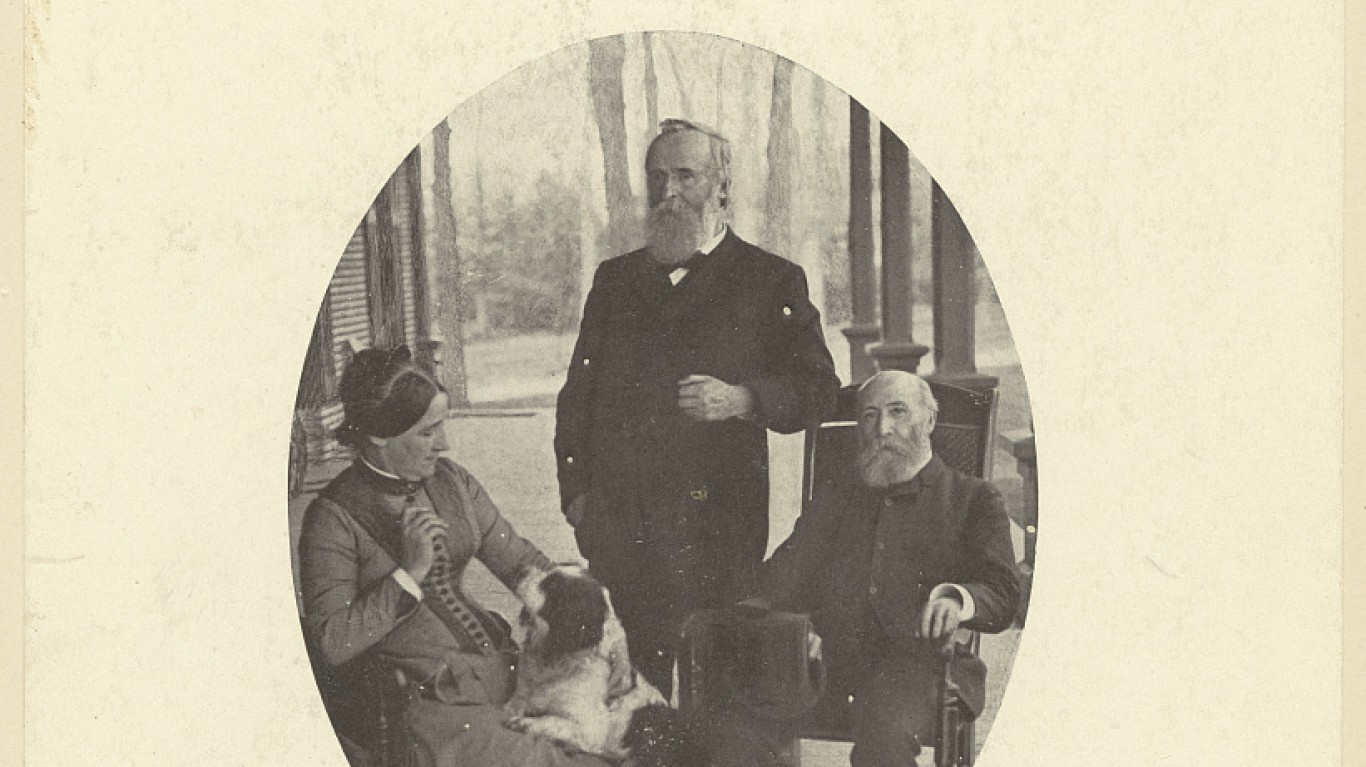
16. Rutherford B. Hayes
> Branch of service: U.S. Army
> Highest military rank achieved: Major General
> Year(s) as president: 1877-1881
Rutherford B. Hayes was well into his law career before he ever joined the military. The Ohio native began defending runaway slaves in court, growing more sympathetic to the abolitionist cause. When the Civil War broke out, Hayes joined a volunteer company, even though he was 40 years old with no military experience and his wife was expecting a fourth child.
Hayes fought bravely, sustaining several major injuries that could have proved fatal. He regularly commanded brigades in major battles from 1862 to 1964. Over the course of the war, he moved up the ranks from major to colonel to brigadier general and eventually to major general.
[in-text-ad]
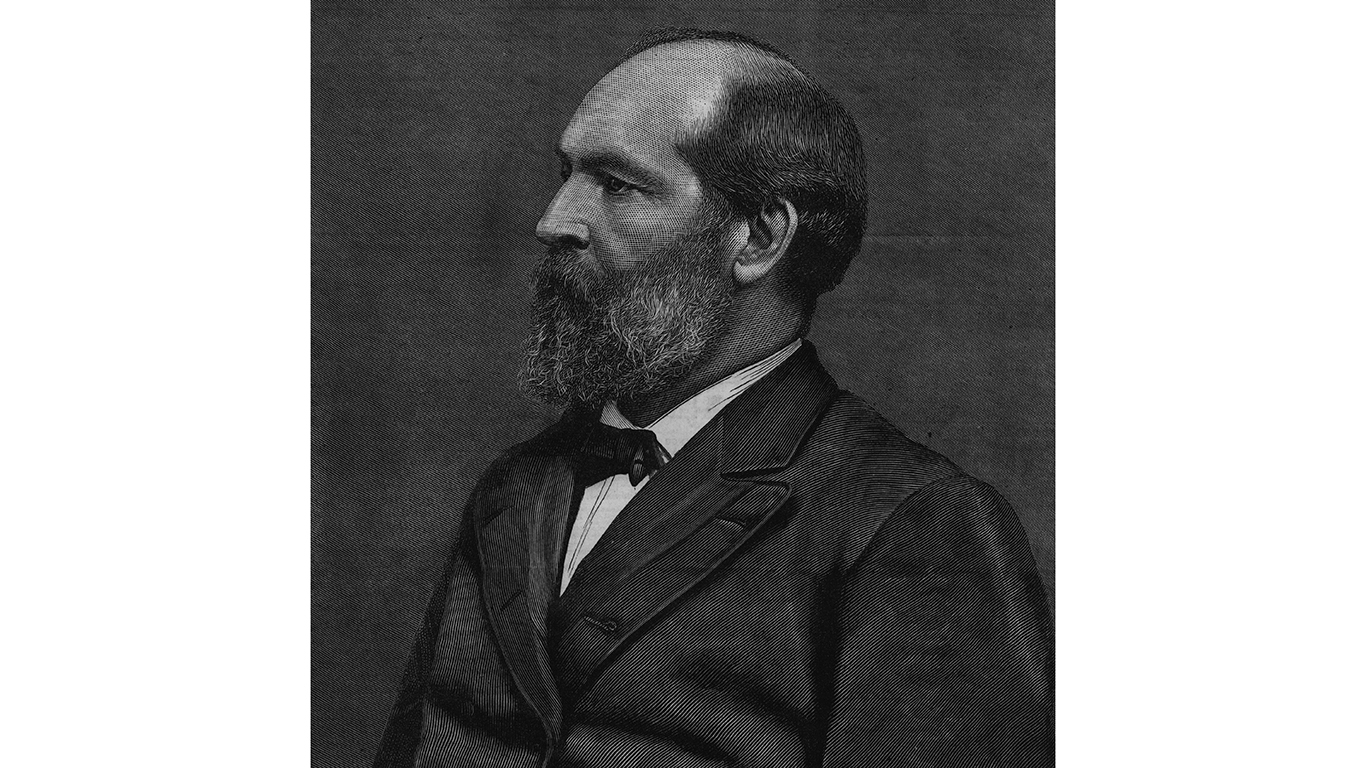
17. James A. Garfield
> Branch of service: U.S. Army
> Highest military rank achieved: Major General
> Year(s) as president: 1881
James Garfield was an ardent abolitionist and a strong opponent of secession. He joined the Union Army to fight for his ideals just after joining the Ohio State Bar in 1861. He organized the 42nd Ohio Infantry and quickly rose to the rank of colonel. His troops seized control of Eastern Kentucky in 1862, despite being outnumbered. By 1863, he was the youngest ever officer to hold the rank of major general.
Garfield’s exploits in the war were so well publicized, he was elected to the U.S. House of Representatives without even campaigning. He resigned from the Army in 1863 to serve in his elected capacity. He advocated for harsh punishments against Confederates, including property seizures of those who seceded and the executions of Confederate leaders.
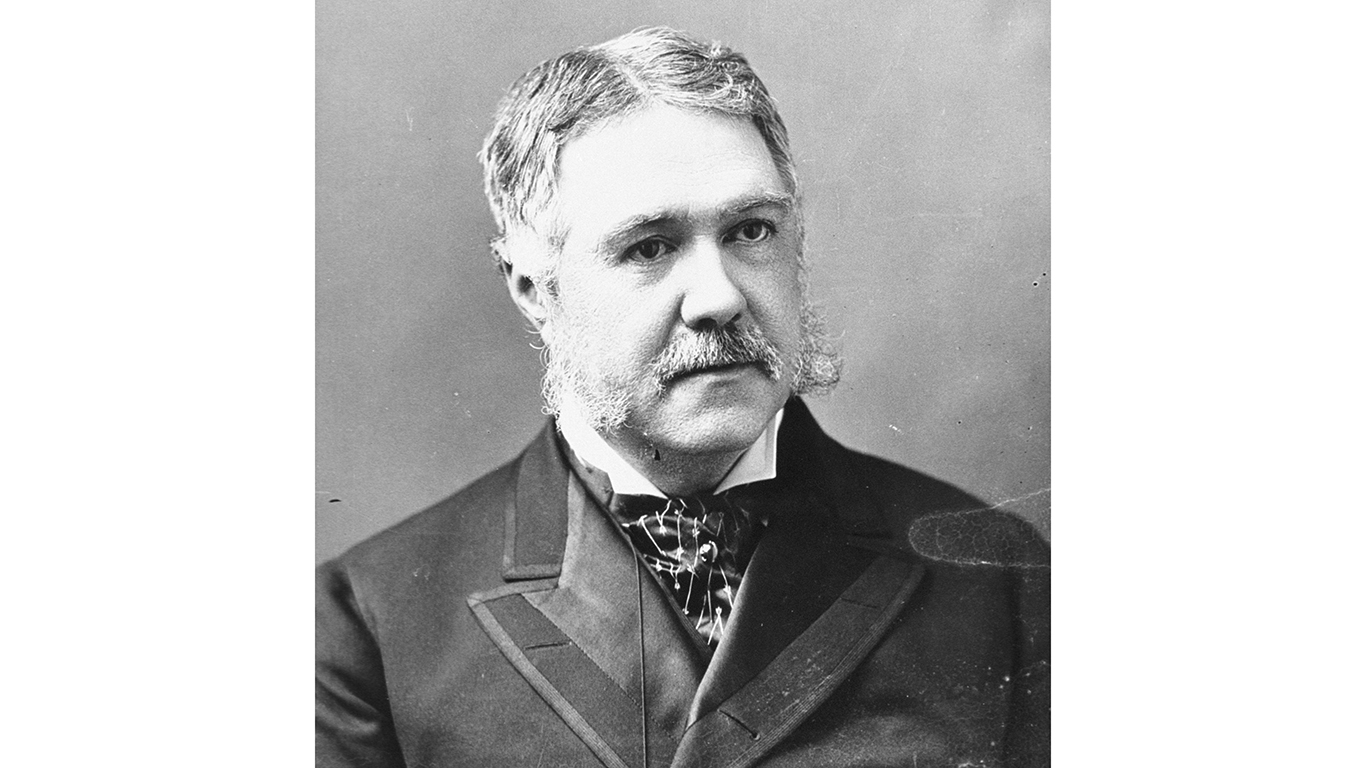
18. Chester A. Arthur
> Branch of service: New York Militia
> Highest military rank achieved: Brigadier General
> Year(s) as president: 1881-1885
Though Chester A. Arthur never saw combat, he was an essential cog in the Union Army war effort. The Civil War began several after Arthur passed the New York bar exam. The pragmatic Arthur was appointed by New York’s governor to be engineer-in-chief, meaning he was responsible for acquiring food and housing for hundreds of thousands of military personnel from New York.
Arthur impressed in his role in the Army, and eventually earned the rank of brigadier general before retiring from duty in 1863. Afterwards, he grew a successful law career by representing clients suing for damages stemming from the war, before moving into politics.

19. Benjamin Harrison
> Branch of service: U.S. Army
> Highest military rank achieved: Brigadier General
> Year(s) as president: 1889-1893
Benjamin Harrison was born into a political family – his great-grandfather signed the Declaration of Indepence, and his grandfather, William Henry Harrison, was the ninth U.S. president. Harrison also sought a political career, practicing law in Indianapolis and campaigning for Abraham Lincoln. When the Civil War began, he volunteered to fight.
Harrison served in the Seventieth Indiana Infantry Regiment beginning in 1862. He served under Maj. Gen. William T. Sherman during his campaign towards Atlanta. Though Sherman lauded Harrison for having “foresight, discipline and a fighting spirit,” Harrison disliked the war. He rose to the rank of brigadier general, before retiring in 1865.
[in-text-ad-2]
20. William McKinley
> Branch of service: U.S. Army
> Highest military rank achieved: Brevet Major
> Year(s) as president: 1897-1901
Born in Ohio in 1843, William McKinley joined the Twenty-third Ohio Volunteer Infantry at the outbreak of the Civil War. McKinley distinguished himself at the battle of Antietam and rose to the rank of second lieutenant and was put on the staff of the future president Col. Rutherford B. Hayes. By the end of the war McKinley’had earned the rank of brevet major – which would prove an asset in his future in politics.

21. Theodore Roosevelt
> Branch of service: U.S. Army
> Highest military rank achieved: Colonel
> Year(s) as president: 1901-1909
Theordore Roosevelt was born into a patrician New York City family on Oct. 27, 1858. After studying at Harvard, he got involved in local politics and was elected to the New York Assembly in 1882. Two years later, both his wife and mother died tragically on the same day, prompting the grief stricken Roosevelt to travel West, where he bought a ranch and became a frontier sheriff. He later returned to New York and continued his career in politics.
Under President McKinley, Roosevelt was appointed the assistant secretary of the Navy – a position he resigned from to volunteer as commander the 1st U.S. Volunteer Cavalry – also known as the Rough Riders – at the outbreak of the Spanish-American War. Roosevelt led with distinction and solidified his reputation as a war hero. Returning east, Roosevelt became governor of New York and was then elected vice president under McKinley – ultimately taking the oval office in 1901 following McKinley’s assassination.
[in-text-ad]
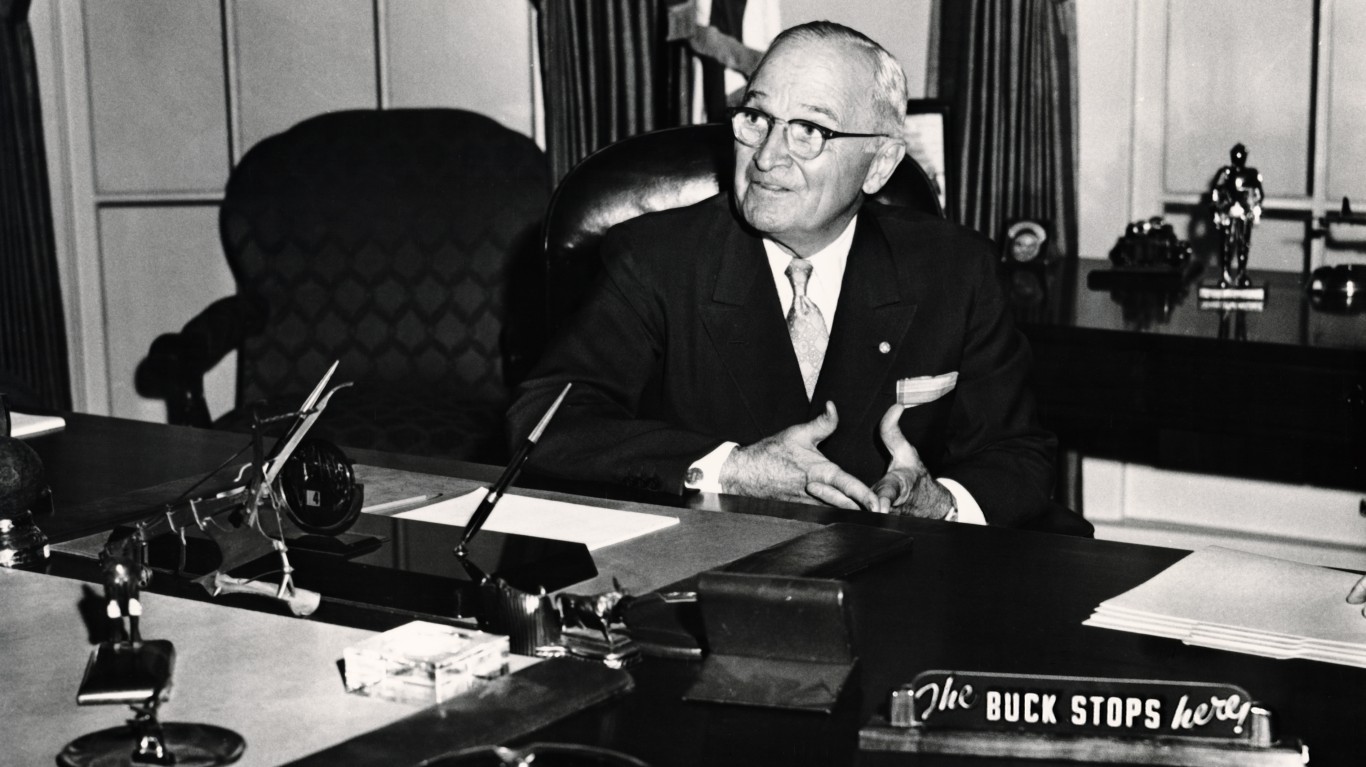
22. Harry S. Truman
> Branch of service: Army Officer Reserve Corps
> Highest military rank achieved: Colonel
> Year(s) as president: 1945-1953
Harry S. Truman served as president of the United States during a tumultuous period in world history. Thrust into power following the death of Franklin Roosevelt, Truman presided over the end of World War II, the Korean War, the beginning of the Cold War, and domestic economic turmoil.
Truman was born in a small Missouri town to a farming family, and would eventually run a haberdashery – a starkly different background than FDR, his patrician presidential predecessor. Also unlike FDR, Truman was a military veteran, having enlisted in the National Guard on the eve of America’s entry to World War I. Rising to the rank of captain, Truman commanded a combat regiment in the Vosges mountains and during the Argonnes campaign in the final months of the war, distinguishing himself with his leadership ability.

23. Dwight D. Eisenhower
> Branch of service: U.S. Army
> Highest military rank achieved: General of the Army
> Year(s) as president: 1953-1961
Drawn to military life at a young age and undeterred by his mother’s pacifism, Dwight Eisenhower matriculated at West Point in 1911. Over the years following his graduation, Eisenhower was stationed at a series of bases where he would work with men who would also eventually serve as generals during World War II, including Douglas MacArthur and George Patton.
The Japanese attack on Pearl Harbor caught the U.S. flat footed, and Eisenhower was selected by Army Chief of Staff George Marshall to put a war plan together. Over the course of World War II, Eisenhower rose in rank from lieutenant colonel to four-star general and would serve as the supreme allied commander, holding together a coalition of primarily British and American forces in joint operations across North Africa and Europe. These included Operation Overlord, in which allied troops stormed the beaches of Normandy in Nazi occupied France. Following the war, Eisenhower served as Army chief of staff and supreme commander of NATO forces in Europe. His distinguished military career ultimately led to two terms in the Oval Office, from 1953 to 1961.
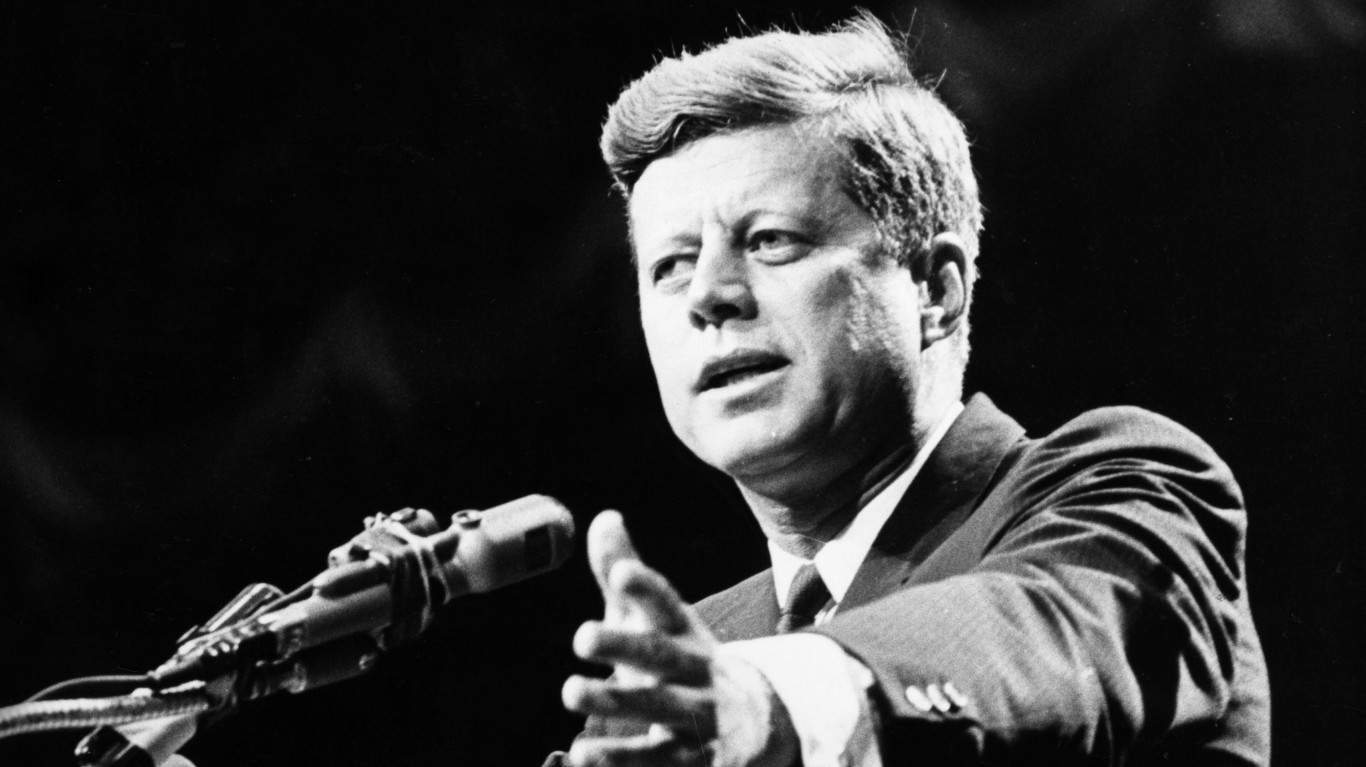
24. John F. Kennedy
> Branch of service: U.S. Naval Reserve
> Highest military rank achieved: Lieutenant
> Year(s) as president: 1961-1963
John F. Kennedy’s heroism during his brief military service was a key factor in his future political success. Following his graduation from Harvard, Kennedy’s health problems precluded his joining the U.S. Navy at the outbreak of World War II. However, through his family’s political connections, he was ultimately able to enlist and was assigned command of a PT boat in the South Pacific.
When Kennedy’s boat was struck by a Japanese destroyer, the future president swam for three miles, pulling a badly injured sailor with his teeth, to lead his surviving crew to a small island where they would be rescued days later. Kennedy’s military career ended with the Paris Peace Treaties, and a new career in politics began when he was elected to Congress in 1946. It would end less than two decades later in Dallas, Texas, in one of the most notorious political assassinations in modern history.
[in-text-ad-2]
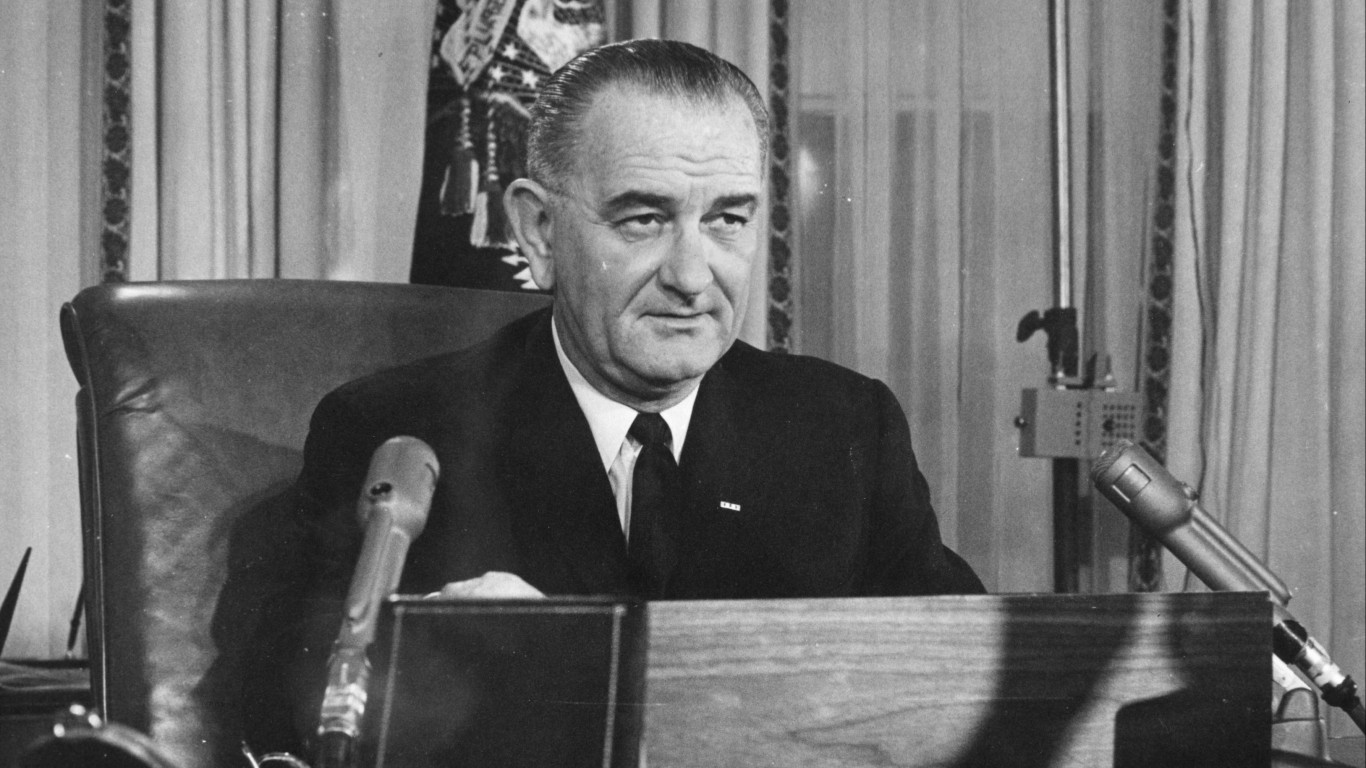
25. Lyndon B. Johnson
> Branch of service: U.S. Naval Reserve
> Highest military rank achieved: Commander
> Year(s) as president: 1963-1969
Ambitious and drawn to politics at a young age, Lyndon Johnson was elected to the U.S. Congress to represent Texas’s 10th District when he was only 28 years old. Leveraging his political connections, Johnson also secured a position as a commissioned officer in the Naval Reserve.
At the outbreak of World War II, Johnson was named the congressional inspector of the Pacific theater. During this period, he flew a single bombing mission, which earned him a Silver Star. In the years following the war, Johnson ascended to the U.S. Senate, where he championed military preparedness. An uneasy political alliance with fellow Democrat John F. Kennedy led to Lyndon Johnson’s ascendancy to the White House.
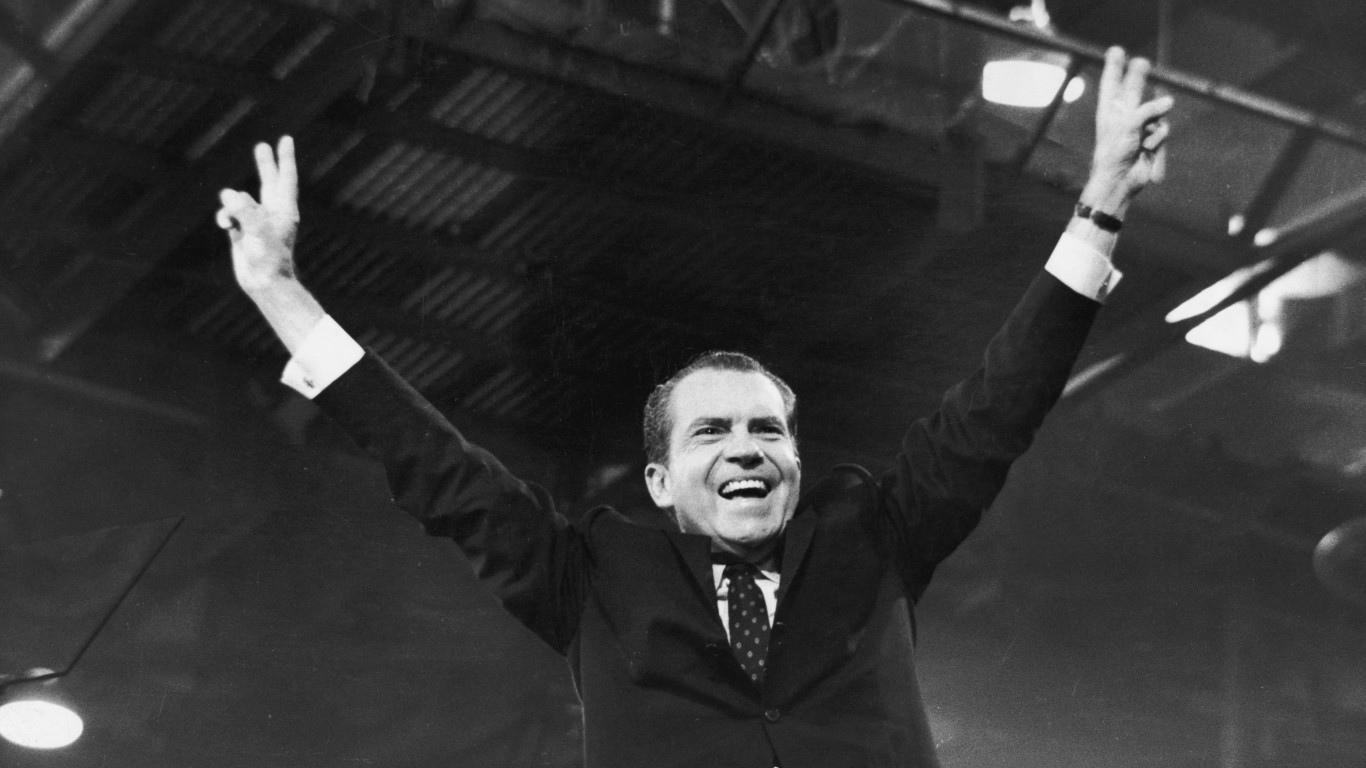
26. Richard M. Nixon
> Branch of service: U.S. Naval Reserve
> Highest military rank achieved: Commander
> Year(s) as president: 1969-1974
Richard Nixon’s legacy will forever be stained by the Watergate scandal, which culminated in his becoming the first and only president to date to resign from office. Still, there is far more to Nixon than the shortcomings he is often defined by – including his military service. After earning a law degree from Duke University in 1937, Nixon was appointed a junior grade lieutenant in the U.S. Naval Reserve at the outbreak of World War II.
Upson successfully completing aviation training, and a brief stint as an executive officer’s aide at a base in Iowa, Nixon volunteered for sea duty and was assigned to the South Pacific, where he planned and supervised loading and unloading of cargo aircraft on embattled islands, including Guadalcanal and the Solomons. Earning a promotion to lieutenant, Nixon was reassigned to Washington D.C. where he worked for the Navy Department in the the Bureau of Aeronautics and ultimately earned the rank of commander. Nixon’s decorations for military service include the American Campaign Medal, the Asiatic-Pacific Campaign Medal, and the World War II Victory Medal.
[in-text-ad]
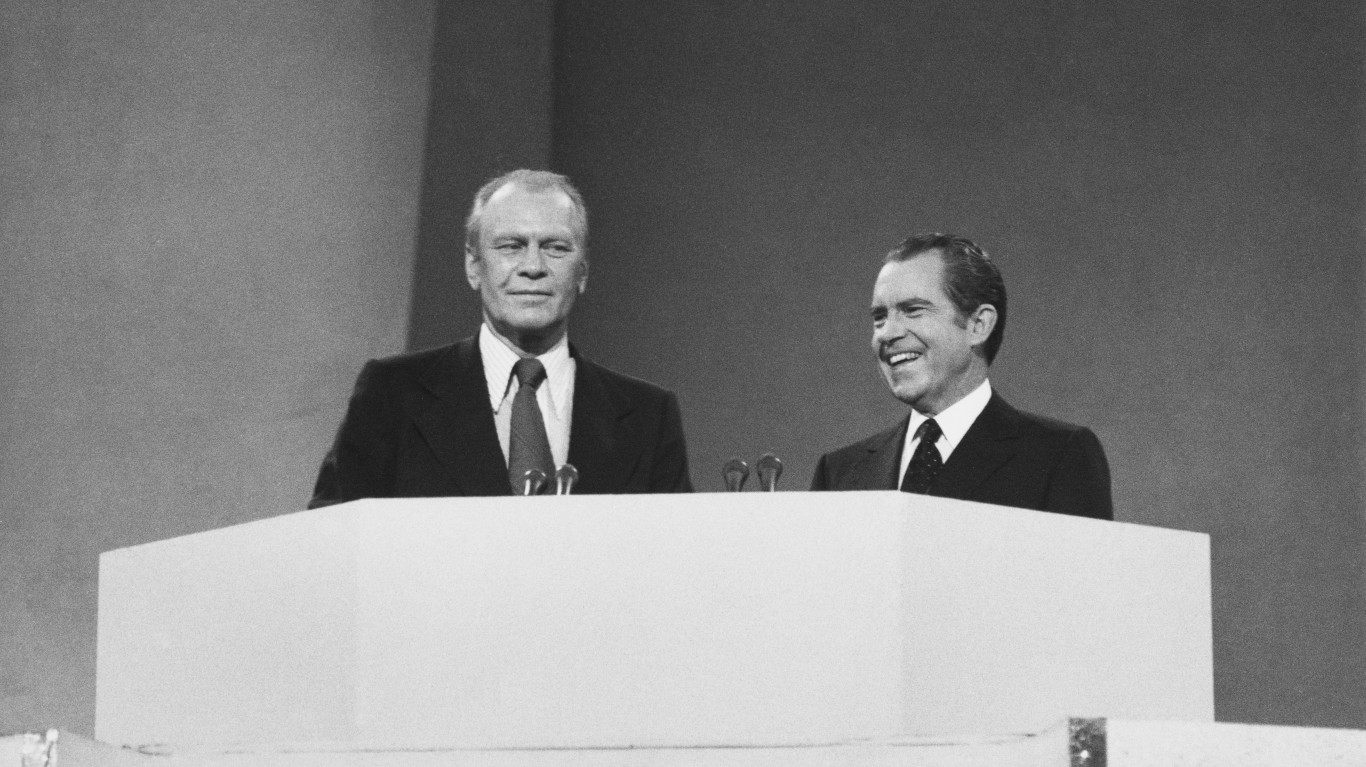
27. Gerald R. Ford
> Branch of service: U.S. Naval Reserve
> Highest military rank achieved: Lieutenant Commander
> Year(s) as president: 1974-1977
A star athlete who turned down offers to play for the Green Bay Packers and Detroit Lions, Gerald Ford instead attended Yale Law School and opened a law practice in Michigan upon graduation. Like several others who would eventually be sworn in as the president of the United States, he put his career on hold when he enlisted in the military following the Japanese attack on Pearl Harbor.
Ford was deployed to the South Pacific as an officer aboard a light aircraft carrier. Over his four years of service, he distinguished himself with his leadership qualities and dependability and earned 10 battle stars. His military experience would have a profound effect on his political convictions, shaping his internationalist view of America’s indispensable role in world affairs.
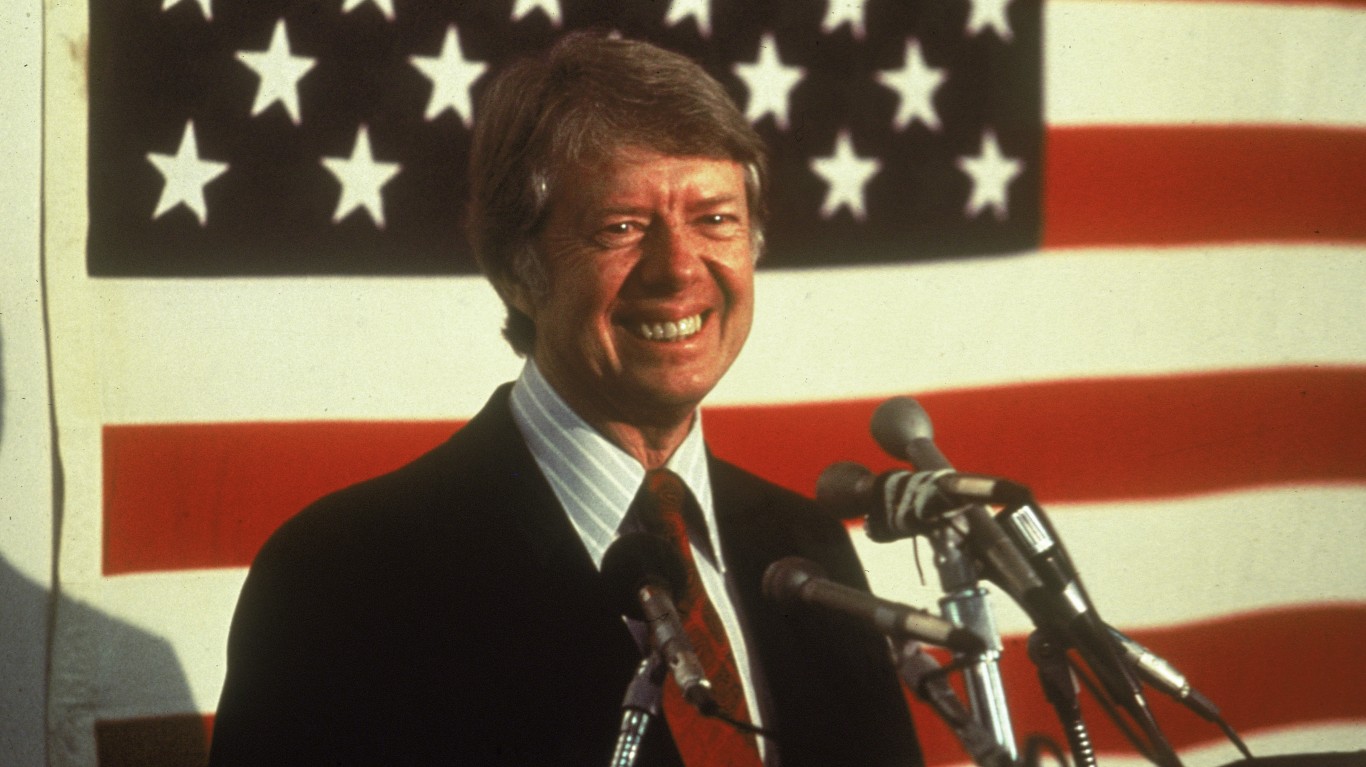
28. Jimmy Carter
> Branch of service: U.S. Navy
> Highest military rank achieved: Lieutenant
> Year(s) as president: 1977-1981
Jimmy Carter was inspired to military service by the events of World War II and was admitted to the highly competitive Annapolis Naval Academy in 1943. Though, by the time he graduated in 1946 in the top 10% of his class, the war had ended. This did not dissuade Carter from pursuing a military career, however, and as a lieutenant, he chose to work on submarines.
Submarines powered by nuclear reactors were a burgeoning technology at the time, and Carter personally taught nuclear engineering to the elite crew of the Seawolf, one of only two nuclear subs being built at the time. Carter’s military career ended abruptly when his father’s death put the future of his family’s farm in jeopardy, prompting him to resign and move back home. Eventually, Carter would make a name for himself in his community, largely on issues of civil rights, and rise to the Georgia state senate and then to the office of governor, up to the United States presidency.

29. Ronald Reagan
> Branch of service: U.S. Army
> Highest military rank achieved: Captain
> Year(s) as president: 1981-1989
Before entering politics, Ronald Reagan had a relatively successful career in Hollywood, appearing in over 50 films and TV shows between 1937 and 1957. Less well known is his history of service in the military, which was also defined in part by his skills as an entertainer. Reagan had been a member of the U.S. Army Cavalry Reserve since the 1930s, and following the events of Pearl Harbor, was called to active duty.
Though he was commissioned as a second lieutenant, his vision problems precluded him from combat tours. Instead, he served mostly with the Army Air Corps First Motion Picture Unit narrating training films and appearing in several other films made to instill a sense of patriotism during the war. Following the war, Reagan developed staunchly conservative political convictions, which, combined with his Hollywood charisma, eventually got him elected as governor of California and then twice as president of the United States.
[in-text-ad-2]
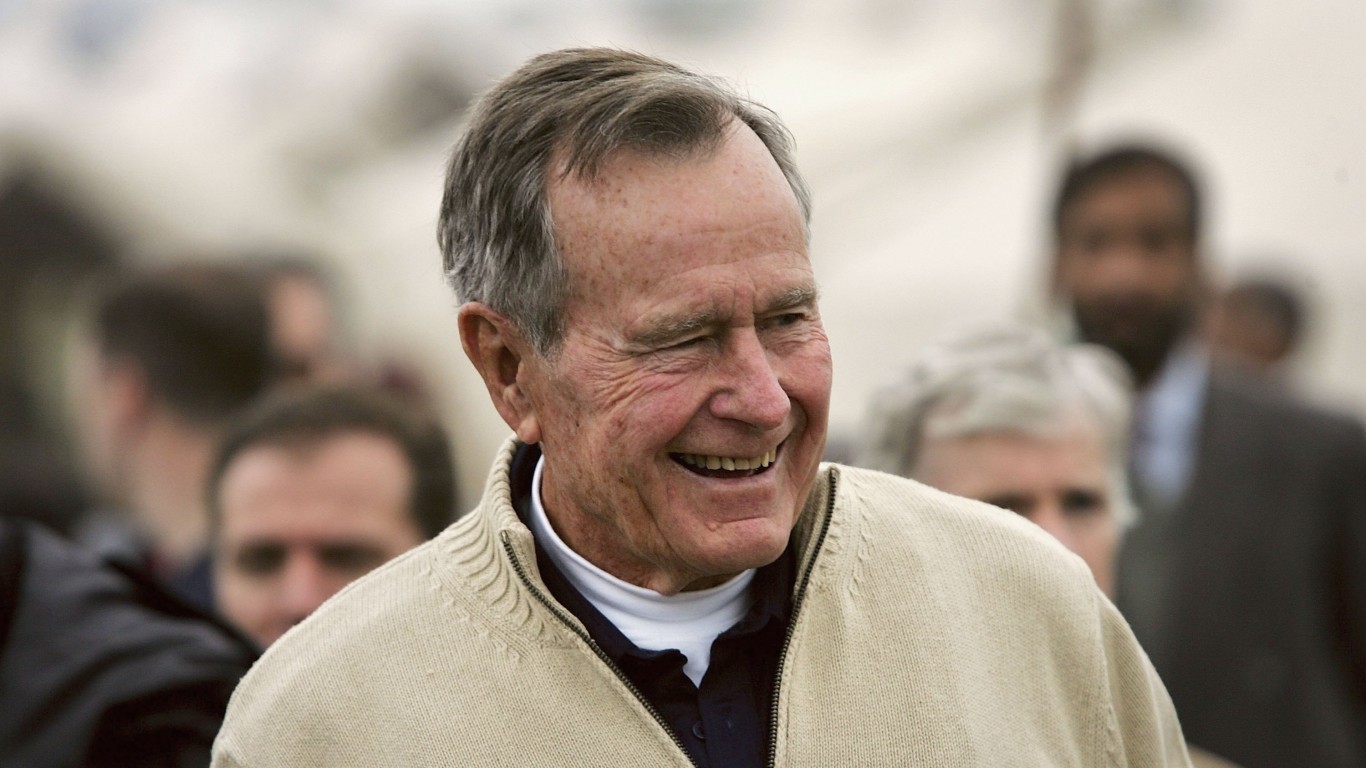
30. George H.W. Bush
> Branch of service: U.S. Navy
> Highest military rank achieved: Lieutenant JG
> Year(s) as president: 1989-1993
Few presidents in the modern era have had as distinguished a career in public service as George H.W. Bush. In addition to serving in the U.S. House of Representatives, and being named U.S. ambassador to the United Nations, U.S. envoy to China, director of the CIA, and elected vice president to Ronald Reagan, George Bush was also a military veteran.
Bush enlisted in the U.S. Navy the day he graduated high school – which was also his 18th birthday. Less than a year later, in 1943, he was flying bombing missions in the South Pacific as the youngest pilot in the Navy. Bush flew 58 combat missions in total and was shot down over the ocean in September 1944 to eventually be rescued by a submarine. For his heroism, he was awarded the Distinguished Flying Cross. He was discharged from service at the end of the war and went on to graduate from Yale University and start a successful oil company in Texas before entering politics – a career move which would culminate in a single term in the White House.

31. George W. Bush
> Branch of service: Texas Air National Guard
> Highest military rank achieved: First Lieutenant
> Year(s) as president: 2001-2009
George W. Bush was born in New Haven, Connecticut, in 1946 to George H.W. Bush, who had recently served as a Navy pilot in the South Pacific in World War II and would go on to become the 41st president of the United States. Like his father, he attended Yale University, and with the ongoing war in Vietnam, enlisted in Texas Air National Guard’s 147th Fighter Group upon graduation. Though he completed Air Force flight training and served as an F-102 fighter pilot, he was never deployed for active duty overseas – a fact that would prove to be something of a liability for his future political career.
Bush went on to become the 43rd president of the United States and is now one of the most controversial figures to have held the office – largely due to his decisions as commander-in-chief. Though he enjoyed a surge in bi-partisan support following the terror attacks of Sept. 11, 2001, less than a year after his inauguration, his popularity tanked over his subsequent invasion of Iraq.
After two decades of reviewing financial products I haven’t seen anything like this. Credit card companies are at war, handing out free rewards and benefits to win the best customers.
A good cash back card can be worth thousands of dollars a year in free money, not to mention other perks like travel, insurance, and access to fancy lounges.
Our top pick today pays up to 5% cash back, a $200 bonus on top, and $0 annual fee. Click here to apply before they stop offering rewards this generous.
Flywheel Publishing has partnered with CardRatings for our coverage of credit card products. Flywheel Publishing and CardRatings may receive a commission from card issuers.
Thank you for reading! Have some feedback for us?
Contact the 24/7 Wall St. editorial team.